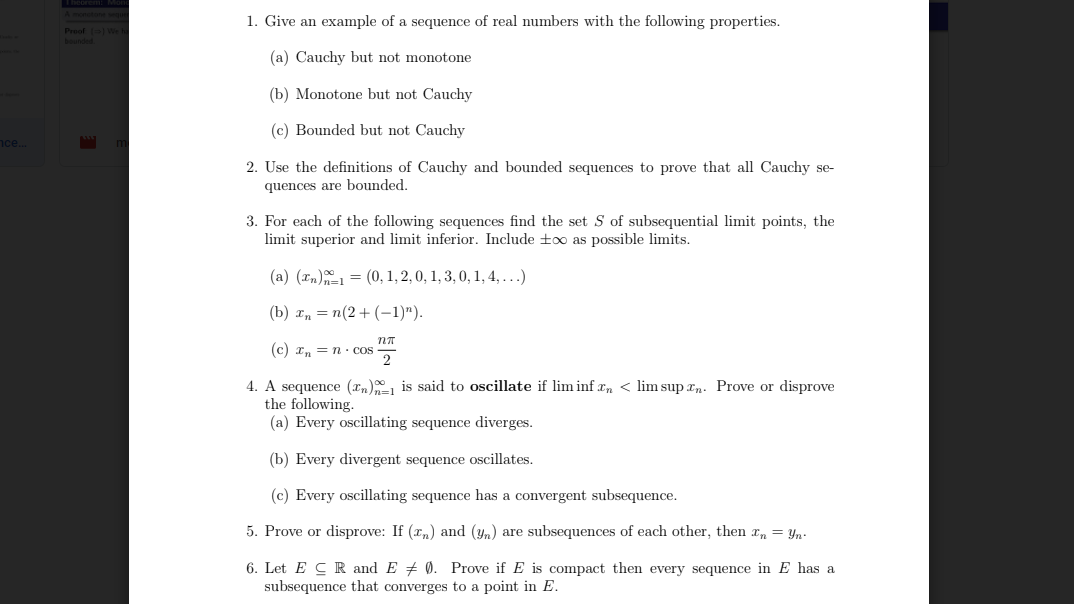3. For each of the following sequences find the set S of subsequential limit points, the limit superior and limit inferior. Include ±∞ as possible limits. (a) (In) = (0, 1, 2, 0, 1, 3, 0, 1, 4, . ..) %3D (b) x„ = n(2+ (–1)"). (c) In = n • Cos 2
3. For each of the following sequences find the set S of subsequential limit points, the limit superior and limit inferior. Include ±∞ as possible limits. (a) (In) = (0, 1, 2, 0, 1, 3, 0, 1, 4, . ..) %3D (b) x„ = n(2+ (–1)"). (c) In = n • Cos 2
Chapter9: Sequences, Probability And Counting Theory
Section9.1: Sequences And Their Notations
Problem 63SE: Follow these steps to evaluate a finite sequence defined by an explicit formula. Using a Tl-84, do...
Related questions
Question
I need help with #3. Thank you.

Transcribed Image Text:1. Give an example of a sequence of real numbers with the following properties.
Proof
) We h
(a) Cauchy but not monotone
(b) Monotone but not Cauchy
(c) Bounded but not Cauchy
nce.
2. Use the definitions of Cauchy and bounded sequences to prove that all Cauchy se-
quences are bounded.
3. For each of the following sequences find the set S of subsequential limit points, the
limit superior and limit inferior. Include too as possible limits.
(a) (In) = (0, 1, 2, 0, 1, 3, 0, 1, 4, ...)
(b) xn = n(2+ (-1)").
(c) xn = n · coS
2
4. A sequence (xn) is said to oscillate if lim inf xn < lim sup rn. Prove or disprove
the following.
(a) Every oscillating sequence diverges.
(b) Every divergent sequence oscillates.
(c) Every oscillating sequence has a convergent subsequence.
5. Prove or disprove: If (x„) and (Yn) are subsequences of each other, then x, = Yn-
6. Let E C R and E + 0. Prove if E is compact then every sequence in E has a
subsequence that converges to a point in E.
Expert Solution
This question has been solved!
Explore an expertly crafted, step-by-step solution for a thorough understanding of key concepts.
This is a popular solution!
Trending now
This is a popular solution!
Step by step
Solved in 2 steps with 2 images

Knowledge Booster
Learn more about
Need a deep-dive on the concept behind this application? Look no further. Learn more about this topic, advanced-math and related others by exploring similar questions and additional content below.Recommended textbooks for you


Algebra & Trigonometry with Analytic Geometry
Algebra
ISBN:
9781133382119
Author:
Swokowski
Publisher:
Cengage


Algebra & Trigonometry with Analytic Geometry
Algebra
ISBN:
9781133382119
Author:
Swokowski
Publisher:
Cengage